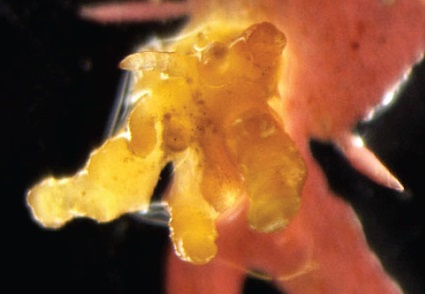Abstract
Red algal parasites are highly host specific organisms that are morphologically reduced with decreased pigmentation. Only found within the Florideophyceae, red algal parasites have evolved within eight orders, with the greatest parasite diversity found in the Ceramiales. A quarter of the ceramialian parasites in the family Delesseriaceae are described in the genus Asterocolax. The initial morphological description of Asterocolax led to the creation of an independent genus devoted to these parasitic species, but molecular data have repeatedly demonstrated that Asterocolax species, and likely many other red algal parasites, resolve within the genera of free-living red algae, often within the same genus as their hosts. Here and in previous studies, phylogenetic analysis of the internal transcribed spacer region of the ribosomal DNA has shown at least six instances of independent evolution of Asterocolax species, mainly interspersed among the free-living macroalgal genera of Phycodrys and Polyneura. As most Asterocolax are sister species to their hosts, they are independently derived from a photosynthetic ancestor, and together, do not form a monophyletic parasitic genus. Here we conduct a long overdue taxonomic revision of the red algal parasitic genus Asterocolax, describe a new species within the genus, and propose nomenclatural changes for four other species to reduce the polyphyletic clades encompassing Asterocolax.
References
<p>Dawson, E.Y. (1994) Some new and unreported sublittoral algae from Cerros Island, Mexico. <em>Bulletin of the Southern California Academy of Sciences</em> 43: 102–112.</p>
<p>Feldmann, J. & Feldmann, G. (1951) Un nouveau genre de Rhodophycée parasite d’une Delesseriacée. <em>Compte Rendu Hebdomadaire des Séances de l’Académie des Science. Paris</em> 223: 1137–1139.</p>
<p>Feldmann, J. & Feldmann, G. (1958) Recherches sur quelques Floridées parasites. <em>Revue Générale de Botanique</em> 65: 49–128.</p>
<p>Freese, J.M. & Lane, C.E. (2017) Parasitism finds many solutions to the same problems in red algae (Florideophyceae, Rhodophyta). <em>Molecular and Biochemical Parasitology</em> 214: 105–111. https://doi.org/10.1016/j.molbiopara.2017.04.006</p>
<p>Goff, L. (1982) The biology of parasitic red algae. <em>In</em>: Round, F.E. & Chapman, D.J. (Eds.) <em>Progress in Phycological Research</em>. Elsevier Biomedical Press, Amsterdam, pp. 289–369.</p>
<p>Goff, L. & Moon, D. (1993) PCR amplification of nuclear and plastid genes from algal herbarium specimens and algal spores. <em>Journal of Phycology</em> 29: 381–384. https://doi.org/10.1111/j.0022-3646.1993.00381.x</p>
<p>Goff, L., Ashen, J. & Moon, D. (1997) The evolution of parasites from their hosts: a case study in the parasitic red algae. <em>Evolution</em> 51: 1068–1078. https://doi.org/10.1111/j.1558-5646.1997.tb03954.x</p>
<p>Kim, C., Kim, Y.S. & Nam, K.W. (2017) New record of the delesseriacean parasitic red alga, <em>Asterocolax denticulatus</em> in Korea. <em>Korean Journal of Environmental Biology</em> 3: 341–344. https://doi.org/10.11626/KJEB.2017.35.3.341</p>
<p>Maggs, C. & Hommersand, M. (1993) <em>Seaweeds of the British Isles</em>, vol. 1. Rhodophyta: part 3A, Ceramiales. The Natural History Museum, London, UK.</p>
<p>Ng, P., Lim, P. & Phang, S. (2014) Radiation of the red algal parasite <em>Congracilaria babae</em> onto a secondary host species, <em>Hydropuntia </em>sp. (Gracilariaceae, Rhodophyta). <em>PLoS ONE </em>9: e97450. https://doi.org/10.1371/journal.pone.0097450</p>
<p>Preuss, M. & Zuccarello, G. (2014) What’s in a name? Monophyly of genera in the red algae: <em>Rhodophyllis parasitica sp. nov.</em> (Gigartinales, Rhodophyta); a new red algal parasite from New Zealand. <em>Algae</em> 29: 279–288. https://doi.org/10.4490/algae.2014.29.4.279</p>
<p>Preuss, M. & Zuccarello, G. (2018) Three new red algal parasites from New Zealand: <em>Chladhymenia oblongifoliaphila</em> sp. nov (Rhodomelaceae), <em>Phycodrys novae-zelandiaephila sp. nov.</em> (Delesseriaceae) and <em>Judithia parasitica sp. nov.</em> (Kallymeniaceae). <em>Phycologia</em> 57: 9–19. https://doi.org/10.2216/17-36.1</p>
<p>Preuss, M. & Zuccarello, G. (2019) Development of the red algal parasite <em>Vertebrata aterrimophila</em> <em>sp. nov.</em> (Rhodomelaceae, Ceramiales) from New Zealand. <em>European Journal of Phycology</em> 54: 175–183. https://doi.org/10.1080/09670262.2018.1536284</p>
<p>Preuss, M., Nelson, W.A. & Zuccarello, G.C. (2017) Red algal parasites: a synopsis of described species, their hosts, distinguishing characters and areas for continued research. <em>Botanica Marina</em> 60: 1–13. https://doi.org/10.1515/bot-2016-0044</p>
<p>Ronquist, F., Teslenko, M., van der Mark, P., Ayres, D.L., Darling, A., Höhna, S., Larget, B., Liu, L., Suchard, M. & Huelsenbeck, J.P. (2012) MrBayes 3.2: Efficient Bayesian phylogenetic inference and model choice across a large model space. <em>Systematic Biology</em> 61: 539–542. https://doi.org/10.1093/sysbio/sys029</p>
<p>Salomaki, E. & Lane, C. (2014) Are all red algal parasites cut from the same cloth? <em>Acta Societatis Botanicorum Poloniae</em> 83: 369–375. https://doi.org/10.5586/asbp.2014.047</p>
<p>Salomaki, E. & Lane, C. (2019) Molecular phylogenetics supports a clade of red algal parasites retaining native plastids: taxonomy and terminology revised. <em>Journal of Phycology</em> 55: 279–288. https://doi.org/10.1111/jpy.12823</p>
<p>Saunders, G. (1993) Gel purification of red algal genomic DNA: an inexpensive and rapid method for the isolation of polymerase chain reaction-friendly DNA. <em>Journal of Phycology</em> 29: 251–254. https://doi.org/10.1111/j.0022-3646.1993.00251.x</p>
<p>Saunders, G. & McDevit, D. (2012) DNA Barcodes. <em>In:</em> Kress, W.J. & Erickson, D.L. (Eds.)<em> DNA Barcodes: Methods and Protocols.</em> 339–353. Springer Science, New York. https://doi.org/10.1007/978-1-61779-591-6_15</p>
<p>Selivanova, O.N. & Zhigadlova, G.G. (2020) <em>Asterocolax denticulatus </em>(Tokida) Feldmann et G. Feldmann, 1951, a New Representative of Delesseriaceaen Algae (Ceramiales: Rhodophyta) in Coastal Waters of Kamchatka (Russia). <em>Russian Journal of Marine Biology</em> 46 (2): 137–139. https://doi.org/10.1134/S1063074020020091</p>
<p>Setchell, W. (1923) Parasitic Florideae, II. <em>University of California Publications in Botany</em> 10: 393–401.</p>
<p>Stamatakis, A. (2006) RAxML-VI-HPC: Maximum likelihood-based phylogenetic analyses with thousands of taxa and mixed models. <em>Bioinformatics</em> 22: 2688–2690. https://doi.org/10.1093/bioinformatics/btl446</p>
<p>Stearn, W.T. (1992) <em>Botanical Latin: History, Grammar, Syntax, Terminology, and Vocabulary, </em>ed. 4. Timber Press, Portland, Oregon.</p>
<p>Tokida, J. (1934) Phycological Observations I. <em>Transactions of the Sapporo Natural History Society</em> 13: 196–202.</p>
<p>Turland, N., Wiersema, J., Barrie, F., <em>et al. </em>[Eds.] (2018) <em>International Code of Nomenclature for algae, fungi, and plants (Shenzen Code) adopted by the Nineteenth International Botanical Congress Shenzen, China, July 2017. </em>Regnum Veg 159. Koeltz Botanical Books, Glashütten. https://doi.org/10.12705/Code.2018</p>
<p>Wagner, F.S. (1954) Contributions to the morphology of the Delesseriaceae. <em>University of California Publications in Biology</em> 27: 279–346.</p>
<p>Wynne, M.J. (1970) Marine algae of Amchitka Island (Aleutian Islands). I. Delesseriaceae. <em>Syesis</em> 3: 95–144.</p>


